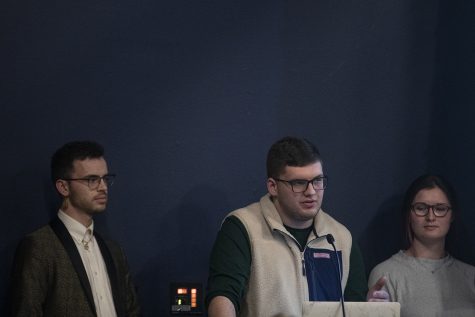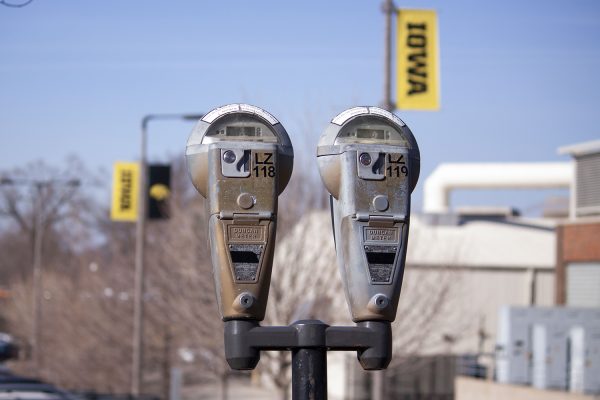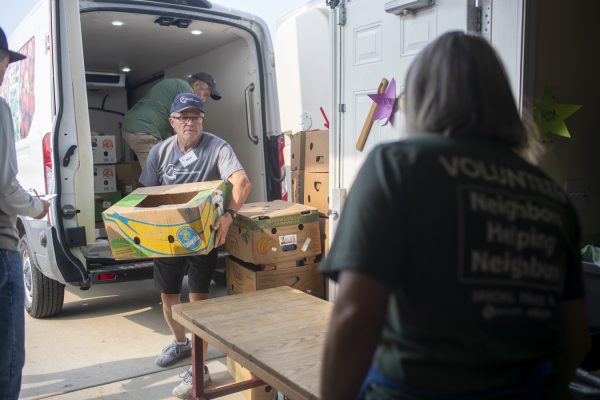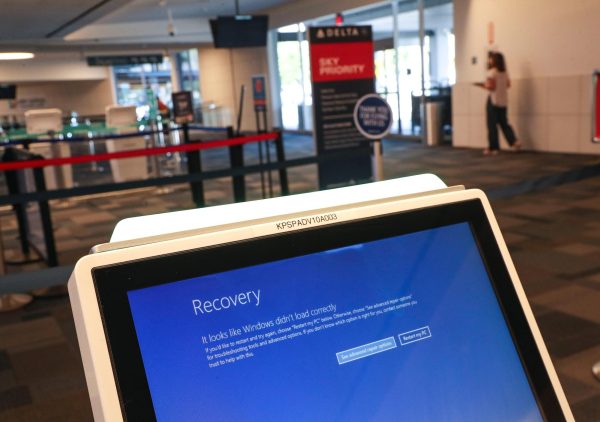UISG decrease in contingency funds limits student organization funding
Student organizations are bearing the brunt of the University of Iowa Student Government’s limited funds after spending half of their contingency budget last semester.
UISG President Noel Mills listens during a UISG meeting in the IMU on Jan. 28. UISG discussed budget issues and student organization allotted funds.
Mohamed Karar, the president of the National Society of Black Engineers at the University of Iowa, stood in front of 48 student government senators and their executive team on Oct. 1 to give an impassioned plea for $3,592.70 in funding. It was for travel expenses to a fall regional conference in St. Louis, Missouri, a key event for members to network with employers for jobs after graduation and internships for the summer.
Karar had already applied through Engage, the site student organizations use to submit budget requests and promote events. But to his surprise, an automatic response immediately denied his request.
“We didn’t know that UISG wasn’t fully funding organizations,” Karar said. “With the denial came a letter that explained their budget restrictions and that they were cutting all funding by 50 percent [that funding period] and weren’t funding travel, period. We weren’t prepared for it, we just usually don’t [get funding] from UISG.”
Karar said sponsors usually make up the bulk of the funding source of the National Society of Black Engineers, rather than the university, since the group is a profession-oriented organization. However, he said they expected funding from UISG, since it usually funds student organizations. Ultimately, UISG funded Karar’s request, but only after they appealed and presented on the Senate floor.
Organizations such as the National Society of Black Engineers asking for more money at weekly student-government meetings is an ordinary occurrence for UISG, especially the 2019 fall semester. Out of 15 UISG meetings’ agendas last semester, one-third discussed the funding of an organization or project.
While UISG continues to adapt and strengthen its funding process, several student-organization members said the chain of command remains unclear to their groups. The funding process begins on Engage but can end after a request is accepted or denied, or it can be taken all the way to the UISG Senate floor. Either way, student organizations can lose funding at every turn, which they say limits their experiences and opportunities on campus.
$72 from every student funds UISG
All undergraduate and graduate students pay UISG a $72 Student Activity Fee each academic year, amounting to $1.872 million said UISG Finance Director Adam Burghduff. UISG’s constitution designates the responsibility of allocating student dollars to the Student Senate.

This fee splits into four budgets, Associate Dean of Students Bill Nelson said. He advises UISG and chairs the Student Activity Fee Committee. UISG and GPSG receive their fixed funding and their contingency funds from this fee. Contingency is a fund allocated by senators and GPSG delegates.
“The Student Activity Fee changes based on the recommendation of the Student Activity Fee Committee in the spring semester,” Nelson said, adding that the committee is made up of five members from UISG and GPSG and five faculty members.
The university last hiked the student activity fee in fiscal 2016 by $1 to fund late-night programming — an initiative aimed at reducing high-risk alcohol consumption — that student organizations can apply for. This came after a steady increase in the fee since 2013. He said next year, the fee will go up again to fund projects with Bijou and FilmScene.
RELATED: Student fees may increase $2 to support Bijou/FilmScene partnership
The student senators are then tasked with parceling out those student dollars to registered student groups on campus. This is why Karar and other organizations request funding through Engage. But appealing a denied funding request requires a more complicated process — a senator must draft legislation and put it on the meeting agenda on an organization’s behalf.
Burghduff said a senator is designated to every organization to answer questions about funding or to help them if they choose to appeal at a senator meeting.
Karar said the only reason he was able to appeal was because he was close friends with a UISG senator, but other organizations like his don’t always have that kind of an in with student government.
The funding process is a lot more complicated than what’s in the group’s governing documents, especially this academic year. Burghduff said there are two budgets for UISG and only one can be used to fund student organizations and student projects.
RELATED: UISG budget is built on student dollars: how the organization wields its budget
Student Activity Fee revenue: $1.872 million
77 percent goes to UISG
- 64 percent funds fixed-cost organizations such as Student Legal Services, the UI cultural houses, and RVAP. This year, that amount was $1.198 million
- 16 percent is allocated for student organizations
- 10 percent goes toward internal operations
- 3 percent is set aside for salaries
- Dollars left over create what is called the contingency fund for UISG’s Student Senate to spend. By the end of the year, the organization’s contingency account must be balanced between $120,000 and $60,000
23 percent of the SAF is set aside for GPSG
Burghduff said the Student Senate and UISG president use this contingency to fund student organization projects outside the purview of the finance committee’s organization funding.
This process, however, became more complex last semester. As The Daily Iowan previously reported March 12, UISG passed a bill 30-9 with three abstentions to allocate $156,179.02 to KRUI to replace outdated equipment.
RELATED: UISG votes to give KRUI funding to replace equipment
UISG paid half the funding — $78,089.51 — immediately after the bill’s passage, and paid the second half of the funding from contingency this fall. This capped the organization’s spending for the academic year.
Funding issues are not foreign to the organization, however. In the past the organization has whittled its contingency fund down between the required $120,000 and $60,000 range, but then has inflated based on returned, unused funds at the start of the next year.
The DI reported on March 19, 2018, UISG had gotten back nearly half of the funds it gave to student organizations in years prior. A total of $145,199 was returned from both semesters in the 2016-17 academic year because the organizations didn’t use all of the funds they requested. The returned funds inflated the contingency account to more than three times its maximum amount at the start of the 2017-18 school year.
While senators believed funding KRUI’s equipment was a worthwhile way to spend UISG’s funds, the decision has limited the amount of money available to allocate to student organizations this academic year.
Burghduff said to adapt to lesser funds, the finance committee created microbudgets to ensure funds could span the two semesters.
“We have a funding period every two weeks,” Burghduff said. “There hasn’t been a set budget. I [believe] I’m the first [UISG] Director of Finance to set a bi-weekly budget limit of about $11,000. Before me, it’s just been we have this amount of money…don’t spend it all. Last [academic] year, we ran out in April.”
Burghduff said this new, two-week system will allow student organizations to apply for and receive funding in the late spring. However, he said, it isn’t a flawless process.
“A problem with this is that sometimes we do have to make percentage cuts, so we don’t pick and choose. The committee doesn’t believe it’s our place to pick and choose what events happen,” he said. “Travel is normally the first thing to get cut this semester and then all else gets cut by a percentage.”
UISG’s percentage cuts to all organization’s requests fluctuates based on the volume of requests in a given funding period, Burghduff said. UISG has made cuts ranging from 20 percent to 50 percent from the funding requests of every organization, Burghduff said.
UISG President Noel Mills said that these across-the-board cuts were the fairest way to curb spending and still allocate something to all the organizations who applied. Mills was the financial director last academic year when UISG approved KRUI funding under then-UISG President Hira Mustafa’s leadership.
“Last year we were able to be more liberal because we had so much money in contingency,” Mills said. “We were able to get the equipment for KRUI which is a decision I stand by, but now we don’t have as much contingency to spend. The percentage cuts are fair and across the board. We aren’t punishing one group. The finance team does their best and is not biased.”
At the beginning of fiscal 2019, UISG’s contingency fund totaled $393,000. A year later, in fiscal 2020, the contingency fund’s starting balance was less than half that, at $102,000.
Mills said the funding periods isn’t a perfect system when it comes to budgets and funding student organizations, but no other Big Ten school has a seamless process either. She said UISG’s main goal was to take steps to improve the funding system and assist student organizations as best as possible.
Other Iowa institutions do not use the same system. Iowa State University Student Government Financial Director Madison Mueller said the group’s funds accumulated from ISU’s $76 student-activity fee are budgeted annually.
“We allocate out $211,000 to a nonprofit funding board in Story County for resources that are not offered on campus,” she said. “The rest of the funding is used in annual allocations in February where any organization on campus has to make a budget for the next fiscal year and they can request funds for conferences, competitions, travel, advertising, and events. There isn’t a cap and all the money goes into an organization’s account by the beginning of the next school year. Every organization has a spending card as well, which is unique to [ISU].”
Mueller said there is limited communication between universities in Iowa on how they spend their funding. She said that, unless members look into it, ISU only compares its system to Big Twelve schools.
Cuts cause students to forego projects
UISG underfunding student organization requests has forced certain groups to cancel or contort plans for yearly activities this semester, like professional trips and events.
Jose Lopez Hernandez, the treasurer of the UI Society of Hispanic Professional Engineers, found himself in the same position as Karar, the leader of NSBE. He applied for funding to go to an October SHPE convention in Pheonix, Arizona and likewise, was denied funding for travel.
But, unlike Karar, Hernandez didn’t know his group could appeal to be fully funded.
“I was upset as well as the whole executive board was upset,” Hernandez said. “We didn’t know how we were going to be able to send anyone to the national convention. This is my first year being treasurer of any organization. We were denied [funding] and I was never told that I could appeal the decision. I found out this was an option when The Daily Iowan reported Taste of Africa and NSBE appealed. I wish we would have, maybe we would have received funding.”
RELATED: UISG approves Taste of Africa and NSBE Regional Conference funding
This appeal process is new this academic year for UISG and the Student Senate. Burghduff said the goal of this administration was to increase financial transparency. UISG lists the information needed to appeal on its website under the governing documents and funding page, but not on Engage.
“We created this new appeals process in line with many other appeals processes across campus and took advice from Dr. Nelson as well as others on making our own process,” he said.
Trevor Smith, president and former treasurer of the UI Percussion Society, said UISG had been an easy outlet for funding in the past, but this year was different.
“The Percussion Society does a typical budget request for an annual percussion conference hosted in Indianapolis,” Smith wrote in an email to DI. “In the past we were given $100 to $200 under [what we requested] sometimes, but I was shocked that it wasn’t even close to the amount we needed.”
Smith said this funding request was the only time his organization went to UISG for funding. He said the organization wasn’t aware of UISG cutting funding requests at all and it cost the organization one of its most important events — the Percussive Arts Society International Convention.
“This [lack of funding] impacted the trip completely, almost none of us went to the conference,” he said. “We already were paying for conference fees, travel, and food and that money was the straw that broke the camel’s back. We did not take the money because it wasn’t worth it. It was frustrating and disappointing.”
Former UISG Sen. Megan Lenss fell victim to a similar funding problem last spring when UISG ran out of funds for student organizations and projects in April.
Lenss spearheaded a project to create a small prairie on the Ashton Cross Country Course. Hers was the next funding request the Senate was supposed to hear before UISG gave out the last of its funding for fiscal 2019 in the spring, she said.
RELATED: UISG funds prairie restoration project
“Last March, we didn’t even get to present because other student organizations received funding that capped the year’s budget before us,” Lenss said.
Lenss pursued her project further and took her funding request to the student Senate floor Nov. 12, a process she said wasn’t easily accessible to everyone.
“Even when I was a senator, I didn’t know what I was doing when it came to asking for funding,” Lenss said. “People will help you, but you have to ask for it… I couldn’t just go in as a student. I had to have a senator sponsor it.”
Lenss said different options of funding-request legislation can be confusing. She chose to approach the president directly because her project fell under the $1,500 threshold and her project wasn’t a part of a student organization. Mills moved the request to Senate, hesitant to dole out $1,400 without Senate approval, a decision Lenss said she understood and supported.
“Trying to get into Senate floor is also a lot of emails asking when you can go,” she said. “They have funding cycles, so you have to know how and when they are and who to talk to. It’s just lengthy and bureaucratic, but it’s going to be like that at all big institutions.”
The process that Lenss went through is the same one as Karar and his organization did earlier in the academic year.
“Luckily, me and my treasurer knew some people who were in the Senate,” Karar said. “We reached out to them and asked them why we were denied. They said there were ways to fight it. We were lucky we knew people [in] the Senate who could guide us through [the process]. If we didn’t know them, we wouldn’t have been able to go through the process.”
UISG officials, like Burghduff, say the percentage cuts, which have impacted the funding of a multitude of organizations, are a nonbiased way to fund student organizations as much as possible.
“I have had 40-plus meetings with student organizations to discuss funding and the Engage process step-by-step,” he said. “We have Senate liaisons for every student organization [who] have sent emails to each organization president to allow people to ask about the funding process. This is a very hard process, it took a long time for me to understand it at an institution as large as [the UI]. We’re available to teach people and we are doing a lot of outreach.”
But, because some student organizations don’t have an inside connection with UISG to know about the appeals process, Hernandez of SHPE UIOWA questioned whether — although unintentional — the cuts were fairly affecting all organizations.
He advised students search elsewhere for money to fund their organizations.
“[Do] not depend on them [UISG] for funding,” he said. “Find other ways to make it work or look for a way to be better prepared in the long run.”

(she/her/hers)
Eleanor Hildebrandt is a senior at the University of Iowa majoring in journalism and mass communication and global health studies. She...


















